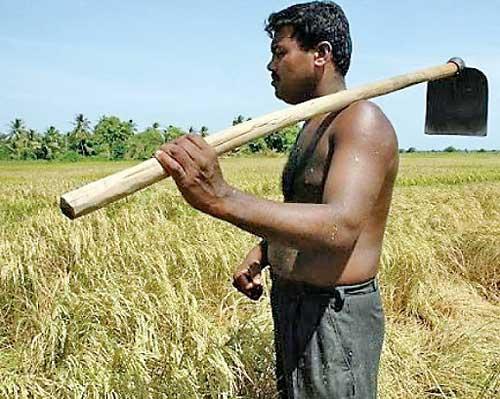25 May 2022 - {{hitsCtrl.values.hits}}
Sri Lankan Prime Minister Ranil Wickremesinghe has sounded an extremely grim warning of a food crisis in the island beginning in August and stretching to March 2023. It will be aggravated by the fact that it could coincide with an expected global food crisis during this period. But all is not lost. Studies reveal that by re-orienting the country’s agricultural policies and adopting modern technologies, the worst can be averted and a firm foundation laid for lasting food security.
island beginning in August and stretching to March 2023. It will be aggravated by the fact that it could coincide with an expected global food crisis during this period. But all is not lost. Studies reveal that by re-orienting the country’s agricultural policies and adopting modern technologies, the worst can be averted and a firm foundation laid for lasting food security.
Current Scenario
Sri Lanka is facing a food crisis brought about by a fertilizer shortage created by the imposition of a 100% ban on chemical fertilizers in April 2021. The ban was eventually lifted, but grievous damage had already been done by that time. Then came the dollar drought which hampered the import of chemical fertilizers. The dollar crunch continues to strangulate agriculture.
Over 30% of Sri Lankans are employed in the agricultural sector. Although the land has potential, issues of productivity and profitability hamper the growth of agriculture in Sri Lanka. Rice occupies 40% of the total crop production in the island. In 2021, during the ‘Yala’ season, the sown area was 501,467 hectares (out of a total of 708,000 hectares). And the harvested area was 496,741 ha. The average yield was 4309 kg per net hectare. The total yield was two million metric tonnes.
According a report in a local Sunday paper, the yield this year is likely to be 500,000 MT. But the annual demand for paddy is 3.2 million MT. Ideally, Sri Lanka should produce 4 million MT of paddy per year to ensure food security.
"Sri Lanka is facing a food crisis brought about by a fertilizer shortage created by the imposition of a 100% ban on chemical fertilizers in April 2021. The ban was eventually lifted, but grievous damage had already been done by that time"
Given the current shortage, rice is imported from India under an Indian Line of Credit (LOC) which can be paid for in Sri Lankan rupees through the State of Bank of India. The G7 countries will assist Sri Lanka in securing debt relief, which will help. However, the exact nature of the help is not known. And the Indian LOC will get exhausted soon, though further help is on the cards. Sri Lanka is in dire need of food imports given the shortage and the skyrocketing prices. Sri Lanka ranks 65 out of 135 countries in the 2021 Global Hunger index, which measures undernourishment and stunted children among other factors. According to the World Bank, 500,000 Sri Lankans fell into poverty (with earnings less than US$ 3.20 a day, or Rs. 1,151 during the pandemic.
Raising Domestic Production
 In their 2016 work entitled: “Sustaining food self-sufficiency of a nation: The case of Sri Lankan rice production and related water and fertilizer demands,” (National Centre for Biotechnology Information) Kyle Frankel Davis found that improvements in rice production can feed 25.3 million Sri Lankans by 2050.
In their 2016 work entitled: “Sustaining food self-sufficiency of a nation: The case of Sri Lankan rice production and related water and fertilizer demands,” (National Centre for Biotechnology Information) Kyle Frankel Davis found that improvements in rice production can feed 25.3 million Sri Lankans by 2050.
But to achieve this growth, consumptive water use and nitrogen fertilizer application may need to increase by as much as 69 and 23%, respectively, he points out. Current rice yields are already approaching the maximum attainable using conventional technologies. Therefore, technological improvements are imperative.
“Further intensification of rice production would necessitate the use of greater amounts of nitrogen fertilizer and irrigation water. There could be a 250% increase in the required volume of irrigation (blue) water and a 23% increase in the amount of applied nitrogen under current resource use efficiency,” he feels.
Closing the Harvest Gap
Davis however feels that it will be better to “close the harvest gap”. This means using the same land for more harvests. Deepak Ray and Jonathan Foley, who studied harvest trends of 177 crops around the world from 1961 to 2011, found that the amount of harvested land rose four times faster than the total amount of cropland from 2000 to 2011, suggesting that the land was being harvested more frequently says Marie Singer in ‘Market Business News’ (Nov 26, 2013). “This would seem to indicate that closing the harvest gap is the preferred method of rice intensification, especially considering that Sri Lankan rice yields will likely plateau in the coming decades,” Davis observes.
Water Issue
Currently, 90% of the total water withdrawals in Sri Lanka are used for agricultural purposes, and rice comprises one-third of Sri Lankan crop production. But achieving increased use of water for more rice production may have serious consequences for the country’s freshwater resources, he cautions.
Therefore, government extension officials have to educate farmers on the value of improving water and nutrient use efficiencies. Davis points to a study which found that irrigated rice production in Sri Lanka has the potential to reduce its water demand by 50% through efficiency improvements in irrigation infrastructure. Nitrogen fertilizer use efficiency can also be increased while still improving yields.
System of Rice Intensification
Further, alternative methods of cultivation such as the System of Rice Intensification (SRI) could be tried out, Davis suggests. Although Sri Lankan farmers cited greater labor requirements as compared to conventional rice farming methods, a three-year study reported that SRI helped improve yields by 44% while markedly reducing the use of synthetic fertilizers.
However, new methods of cultivation should also incorporate carbon and nitrogen footprints, soil loss, and the influence of climate, Davis adds. Climate change is particularly relevant to Sri Lanka because the vast majority of the country’s rice supply is produced in the Dry Zone.
"The yield this year is likely to be 500,000 MT. But the annual demand for paddy is 3.2 million MT. Ideally, Sri Lanka should produce 4 million MT of paddy per year to ensure food security"
Pollution due to Fertilizers
Davis also points out that preventing crop stress during times of relative water scarcity may mean that aquatic ecosystems will receive greater fertilizer pollution. According to UN and International Water Management Institute indicators, several rice-producing areas in the world are expected to experience severe water scarcity in the next ten years.
Exporting Rice
With many Asian countries (e.g., India, Pakistan, and Indonesia) expected to see rapid population growth in the coming decades (UN 2012) and with climate change contributing to elevated food prices and increased food price volatility, Sri Lanka could become a regional exporter of rice, Davis says. Increased rice production will ensure that Sri Lanka is not import-reliant and is therefore less vulnerable to spikes in food prices, he adds.
coming decades (UN 2012) and with climate change contributing to elevated food prices and increased food price volatility, Sri Lanka could become a regional exporter of rice, Davis says. Increased rice production will ensure that Sri Lanka is not import-reliant and is therefore less vulnerable to spikes in food prices, he adds.
“Sri Lanka’s reduced dependence on food imports is also important given recent evidence that the global food system has become more vulnerable to shocks as reliance on food trade has increased and that exporting countries may reduce exports in times of food scarcity,” Davis says arguing for self-sufficiency.
Fertilizer Subsidy
However, given that paddy cultivation employs nearly two million Sri Lankan farmers, governments are under political pressure to continue providing a fertilizer subsidy. “Though the subsidy has helped increase land productivity and rice yields, it continues to place a heavy burden on the Sri Lankan GDP while encouraging the over-application of fertilizers,” Davis points out. He calls for a more prudent, scientific and non-political policy on fertilizers.
27 Nov 2024 51 minute ago
27 Nov 2024 3 hours ago
27 Nov 2024 4 hours ago
27 Nov 2024 4 hours ago
27 Nov 2024 4 hours ago